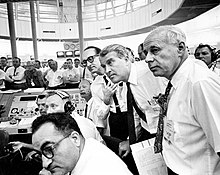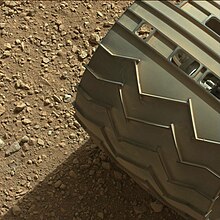The National Aeronautics and Space Administration (NASA) is the United States government agency responsible for the civilianspace program as well as aeronautics and aerospace research.
President Dwight D. Eisenhower established the National Aeronautics and Space Administration (NASA) in 1958 with a distinctly civilian (rather than military) orientation encouraging peaceful applications in space science. The National Aeronautics and Space Actwas passed on July 29, 1958, disestablishing NASA's predecessor, the National Advisory Committee for Aeronautics (NACA). The new agency became operational on October 1, 1958.
Since that time, most US space exploration efforts have been led by NASA, including the Apollo moon-landing missions, the Skylabspace station, and later the Space Shuttle. Currently, NASA is supporting the International Space Station and is overseeing the development of the Orion Multi-Purpose Crew Vehicle, the Space Launch System and Commercial Crew vehicles. The agency is also responsible for the Launch Services Program (LSP) which provides oversight of launch operations and countdown management for unmanned NASA launches.
NASA science is focused on better understanding Earth through the Earth Observing System, advancing heliophysics through the efforts of the Science Mission Directorate's Heliophysics Research Program, exploring bodies throughout the Solar System with advanced robotic spacecraft missions such as New Horizons, and researching astrophysics topics, such as the Big Bang, through the Great Observatories and associated programs.NASA shares data with various national and international organizations such as from the Greenhouse Gases Observing Satellite.
Creation
From 1946, the National Advisory Committee for Aeronautics (NACA) had been experimenting with rocket planes such as the supersonic Bell X-1. In the early 1950s, there was challenge to launch an artificial satellite for the International Geophysical Year (1957–58). An effort for this was the American Project Vanguard. After the Soviet launch of the world's first artificial satellite (Sputnik 1) on October 4, 1957, the attention of the United States turned toward its own fledgling space efforts. The US Congress, alarmed by the perceived threat to national security and technological leadership (known as the "Sputnik crisis"), urged immediate and swift action; President Dwight D. Eisenhower and his advisers counseled more deliberate measures. This led to an agreement that a new federal agency mainly based on NACA was needed to conduct all non-military activity in space. The Advanced Research Projects Agency (ARPA) was created in February 1958 to develop space technology for military application.
On July 29, 1958, Eisenhower signed the National Aeronautics and Space Act, establishing NASA. When it began operations on October 1, 1958, NASA absorbed the 46-year-old NACA intact; its 8,000 employees, an annual budget of US$100 million, three major research laboratories (Langley Aeronautical Laboratory, Ames Aeronautical Laboratory, and Lewis Flight Propulsion Laboratory) and two small test facilities. A NASA seal was approved by President Eisenhower in 1959. Elements of the Army Ballistic Missile Agency and the United States Naval Research Laboratory were incorporated into NASA. A significant contributor to NASA's entry into the Space Race with the Soviet Union was the technology from the German rocket program led by Wernher von Braun, who was now working for the Army Ballistic Missile Agency (ABMA), which in turn incorporated the technology of American scientist Robert Goddard's earlier works. Earlier research efforts within the US Air Force and many of ARPA's early space programs were also transferred to NASA.In December 1958, NASA gained control of the Jet Propulsion Laboratory, a contractor facility operated by the California Institute of Technology.
Space flight programs
NASA has conducted many manned and unmanned spaceflight programs throughout its history. Unmanned programs launched the first American artificial satellites into Earth orbit for scientific and communications purposes, and sent scientific probes to explore the planets of the solar system, starting with Venus and Mars, and including "grand tours" of the outer planets. Manned programs sent the first Americans into low Earth orbit (LEO), won the Space Race with the Soviet Union by landing twelve men on the Moon from 1969 to 1972 in the Apollo program, developed a semi-reusable LEO Space Shuttle, and developed LEO space station capability by itself and with the cooperation of several other nations including post-Soviet Russia. Some missions include both manned and unmanned aspects, such as the Galileo probe, which was deployed by astronauts in Earth orbit before being sent unmanned to Jupiter.
Recent and planned activities by NASA:
NASA's ongoing investigations include in-depth surveys of Mars and Saturn and studies of the Earth and the Sun. Other active spacecraft missions are MESSENGER for Mercury, New Horizons (for Jupiter, Pluto, and beyond), and Dawn for the asteroid belt. NASA continued to support in situ exploration beyond the asteroid belt, including Pioneer and Voyager traverses into the unexplored trans-Pluto region, and Gas Giant orbiters Galileo (1989–2003), Cassini (1997–), and Juno (2011–).
The New Horizons mission to Pluto was launched in 2006 and successfully performed a flyby of Pluto on July 14, 2015. The probe received a gravity assist from Jupiter in February 2007, examining some of Jupiter's inner moons and testing on-board instruments during the flyby. On the horizon of NASA's plans is the MAVEN spacecraft as part of the Mars Scout Program to study the atmosphere of Mars.
On December 4, 2006, NASA announced it was planning a permanent moon base. The goal was to start building the moon base by 2020, and by 2024, have a fully functional base that would allow for crew rotations and in-situ resource utilization. However, in 2009, the Augustine Committee found the program to be on a "unsustainable trajectory." In 2010, President Barack Obama halted existing plans, including the Moon base, and directed a generic focus on manned missions to asteroids and Mars, as well as extending support for the International Space Station.
Since 2011, NASA's strategic goals have been
- Extend and sustain human activities across the solar system
- Expand scientific understanding of the Earth and the universe
- Create innovative new space technologies
- Advance aeronautics research
- Enable program and institutional capabilities to conduct NASA's aeronautics and space activities
- Share NASA with the public, educators, and students to provide opportunities to participate
In August 2011, NASA accepted the donation of two space telescopes from the National Reconnaissance Office. Despite being stored unused, the instruments are superior to the Hubble Space Telescope.
In September 2011, NASA announced the start of the Space Launch System program to develop a human-rated heavy lift vehicle. The Space Launch System is intended to launch the Orion Multi-Purpose Crew Vehicle and other elements towards the Moon, near-Earth asteroids, and one day Mars.The Orion MPCV conducted an unmanned test launch on a Delta IV Heavy rocket in December 2014.
On August 6, 2012, NASA landed the rover Curiosity on Mars. On August 27, 2012, Curiosity transmitted the first pre-recorded message from the surface of Mars back to Earth, made by Administrator Charlie Bolden:
| “ | Hello. This is Charlie Bolden, NASA Administrator, speaking to you via the broadcast capabilities of the Curiosity Rover, which is now on the surface of Mars.
Since the beginning of time, humankind’s curiosity has led us to constantly seek new life...new possibilities just beyond the horizon. I want to congratulate the men and women of our NASA family as well as our commercial and government partners around the world, for taking us a step beyond to Mars.
This is an extraordinary achievement. Landing a rover on Mars is not easy – others have tried – only America has fully succeeded. The investment we are making...the knowledge we hope to gain from our observation and analysis of Gale Crater, will tell us much about the possibility of life on Mars as well as the past and future possibilities for our own planet. Curiosity will bring benefits to Earth and inspire a new generation of scientists and explorers, as it prepares the way for a human mission in the not too distant future. Thank you.
To know more about it go to nasa official website:www.nasa.gov
|




0 comments:
Post a Comment